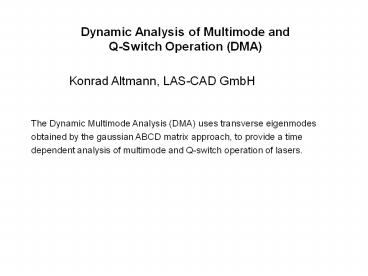LASCAD SEMINAR ILOPE 2005 - PowerPoint PPT Presentation
Title:
LASCAD SEMINAR ILOPE 2005
Description:
... photon densities ... Note that the photon density inside the crystal is by a ... Here is the photon distribution of mode i at position zA ... – PowerPoint PPT presentation
Number of Views:111
Avg rating:3.0/5.0
Title: LASCAD SEMINAR ILOPE 2005
1
Dynamic Analysis of Multimode and Q-Switch
Operation (DMA)
Konrad Altmann, LAS-CAD GmbH
The Dynamic Multimode Analysis (DMA) uses
transverse eigenmodes obtained by the gaussian
ABCD matrix approach, to provide a time dependent
analysis of multimode and Q-switch operation of
lasers.
2
For this purpose the transverse mode structure in
the cavity is approximated by a set of M
Hermite-Gaussian (HG) or Laguerre-Gaussian (LG)
modes.
Since HG and LG modes are representing sets of
orthogonal eigenfunctions with different
eigenfrequencies, it is assumed that each
transverse mode oscillates inde-pendently, and
therefore the influence of short-time mode
locking and interference effects between the
modes can be neglected on average.
3
Multimode Rate Equations
i1,,M
Si(t) number of photons in transverse mode i
SC(t) total number of photons in the
cavity si,C(x,y,z) normalized density
distribution of photons
4
- nA refractive index of the active medium
- c vacuum speed of light
- N(x,y,z,t) N2 N1 population inversion density
(N1 0) - RP?PPa/h?P pump rate
- ?P pump efficiency
- Pa(x,y,z) absorbed pump power density
- s effective cross section of stimulated
- emission
- tC mean life time of laser photons in the
- cavity,
- tf spontaneous fluorescence life time of
- upper laser level
- Ndop doping density.
5
An important quantity is the mean life time tC of
the laser photons in the cavity. It is given by
where optical path length of the
cavity trtrip period of a full roundtrip
of a wavefront Lroundtrip round trip loss Rout
reflectivity of output mirror
6
- A detailed theoretical description of the DMA
code is given in the LASCAD manual Sect. 7.
In the following am only giving a comprehensive
description of the main features.
7
To obtain the normalized photon densities si
(iC 1,,M) the complex wave amplitudes
ui(x,y,z) are normalized over the domain
OO2Dx0,LR of the resonator with length LR.
Here the ui (i1,,M) denote the amplitudes of
the individual modes, whereas uC denotes the
amplitude of the superposition of these modes In
our incoherent approximation absolute square of
this superposition is given by
8
The amplitudes ui and the normalized photon
distributions si are connected by the following
relation
Note that the photon density inside the crystal
is by a factor nA higher than outside due to the
reduced speed of light.
9
Laser Power Output
The laser power output is obtained by computing
the number of photons passing the output coupler
per time unit. In this way one obtains for the
power output delivered by the individual
transverse modes
Rout reflectivity of output mirror trtrip
period of a full roundtrip of a wavefront
10
This plot shows a typical time dependence
obtained for the total power output.
Since the computation starts with population
inversion density N(x,y,z,t)0, a spiking
behavior can be seen at the beginning, which
attenuates with increasing time.
11
Beam Quality M²
The beam quality factors Mx² and My² are computed
according to Siegman and Townsend using the
expressions
Here pi and qi are the transverse mode orders of
the i-th gaussian mode in x- and y-direction,
respectively. The coefficients ci(t) are the
relative contributions of the inividual modes to
the total power output.
12
This plot shows a typical time dependence
obtained for the beam quality.
Again the spiking at the beginning is caused by
the vanishing inversion density N(x,y,z,t) at the
start of the computation.
13
Modeling of Q-Switch Operation
Time dependence of active Q-switching is
cha-racterized by three time periods which can be
described as follows
- load period period
- pulse period period Iia
- relaxation period period IIb
14
Development of population inversion and laser
power during these periods is shown schematically
in this plot
15
During the load peiod, it is assumed that the
photon number in the individual modes vanishes.
This simplifies the rate equations to
i1,,M
To prevent lasing during the load period a high
artificial intra-cavity loss is introduced
16
After the load period this artificial loss is
removed that means the Q-switch is opend and the
pulse can develop.
A typical pluse shape ontained with our DMA code
is shown on the next slide.
17
(No Transcript)
18
Apertures and Mirrors with Variable Reflectivity
Apertures and output mirrors with variable
reflectivity can be taken into account in the
Dynamic Multimode Analysis by introducing
specific losses Li for the individual modes.
This leads to mode specific mean life times tC,i
of the photons due to mode specific losses.
19
In case of an aperture with radius RA at position
zA and a mirror with uniform reflectivity, the
mode specific losses are described by
Here is the photon distribution of
mode i at position zA normalized with respect to
the transverse coordinates
20
In case of a mirror with variable reflectivity,
for instance a gaussian mirror, the mode specific
losses are described by
where Rout is a function is a function or
transverse coordinates x and y.
21
An important realisation of mirrors with variable
reflectivity are supergaussian output mirrors.
The reflectivity of such mirrors is described by
Here Rmin is a peripheral bottom reflectivity.
22
With supergaussian mirrors the beam quality can
be improved considerably without loosing too much
power output. This shall be demonstrated.
This shall be demonstrated by the following
example.
23
Beam profile without confining aperture. Power
output 6.87 W
24
Beam profile for the same configuration with
supergaussian aperture. Power output 4.22 W






























